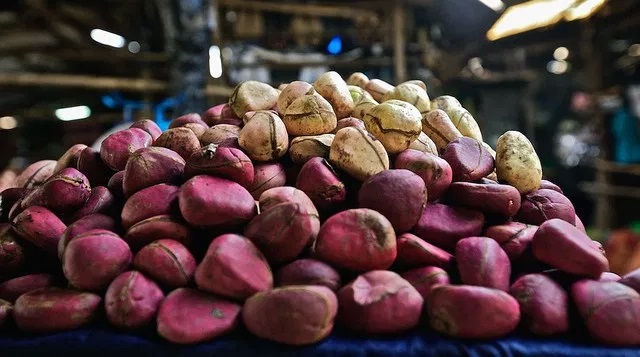“Ghana Overtakes Nigeria Kolanut Production” Kolanut is an important economic cash crop, commercially produced in tropical rainforests of Central and West Africa. It is a perennial crop that grows well in hot humid climates.
Aside Nigeria, Ghana, Cameroon, Sierra Leone and Cote d’Ivoire are other leading producers of Kolanut in the continent. About 40 Kola species exist in West Africa, however, the Kola species that are of economic importance in Nigeria are C. acuminata and C. nitida. Kolanut serves as a flavoring ingredient in beverages otherwise known as “cola” and contains stimulants comprising of about two per cent caffeine, as well as kolanin and theobromine. It also has industrial usage in pharmaceuticals, production of soft drinks wines and in confectionaries.
While it is eaten more by the northerners and easterners, it is widely grown in the South West-Ogun, Kwara, Osun and Oyo State, although two communities in Niger State are also said to produce it in large quantities. The report has it that 90 per cent of the Kolanut produced in Nigeria is consumed within the country, while 10 per cent is exported. The country’s cultivation of Kolanut, according to reports is said to be ecologically limited to the rainforest zones of the southern and riverine areas of the Savannah region.
Kola nuts, which has for hundreds of years served as an important article of internal trade in Nigeria and other parts of Africa, are a common sight in markets, cities and villages. They are often sold by street vendors at bus stops and train depots. In the past, Nigeria occupies number one position in terms of production in the world, accounting for 70 per cent of world output, according to the Integrated Kolanut Producers, Marketers, and Exporters Association of Nigeria (IKPMEAN). But the country has since been overtaken by Ghana.
The Guardian learnt that in the 1970s and 80s; the country was producing over 200,000 metric tonnes (mt) of the produce annually, but currently it’s struggling to produce a meager 20,000 mt, a development attributed to the scarcity of the product locally. Of late, the price of the commodity has risen astronomically, costing five times more in the last three years. A retailer, who spoke with The Guardian, Madam Ajoke Alebiosu claims the price increase is due to poor harvests, caused by climate change and many other factors beyond their control.
“The recent Kolanut I bought was a total loss. As usual, I buried the fresh nuts on the bare ground, covered it with leaves to get the testa rotten, for a period of three to four days as we usually do it. The essence is to ensure that the nuts wrets and turn black. During the process, the premature nuts also mature in this process. But to my surprise, the whole package I bought got rotten before I could remove it. This is basically due to heat,” she said.
Pa Ayinla Abegunrin, a 90-year-old farmer, lamented that while the demand is rising, production remains low because many of the trees in Nigeria are unfruitful or have very low yield due to self-and-cross incompatibility, partial and total sterility, inefficient natural pollination, old age, field and storage pests, and diseases. He added that pests are major challenges facing cultivation of the crop. “The major pest of Kolanuts is Kolanut weevil, both prior to the harvest and during storage. It is the most destructive insect pest of Kolanut in Nigeria.”
The Guardian learned that Kolanut weevils-Balanogastris kolae and Sophrorhinus are the most destructive field-to-store pests of Kolanuts in West Africa. Kolanut weevil is identified as field-to-store pests of Kolanut capable of causing 30–70 per cent damage to stored nuts, while 100 per cent damage has been recorded in cases of late harvest and in storage. Other pest and attack to Kola nuts are Mould/Fungal, Ants, and Parasitic Plants, among others.
Currently, Nigeria is not earning up to $10m annually in foreign exchange from Kolanut because not many people are really exporting the product. Managing Director/CEO of Bama Farms, Prince Wale Oyekoya told The Guardian that in the 1970s and 80s, “we still make up to $25m then, which ought to be more than that now, but because the sector has been totally neglected, we are not even making up to the said $10m, in terms of revenue generation.
“Look at areas where Kolanut processing plants are based in the North and South, you’ll discover that they have already become moribund, so these are the problems we have been having, we don’t really add value. So when you add value to something, you’ll be able to promote it and do more of it.”The former Chairman, Lagos Chamber of Commerce and Industry (LCCI)’s agriculture sector, linked the problem to the government’s neglect of agriculture; poor funding, and oil discovery that has made Nigerians lazy. “It has negatively affected employment generated by the sector because during processing a lot of people are employed. We are not really where we supposed to be, we need government to do more because oil is already drying and countries that rely on oil are now using ethanol and others.”
Oyekoya lamented that agriculture has been so much neglected after the discovery of oil and “our oil boom has become oil doom now because it has made us to be lazier. We used to be the major exporter of Kolanut in the 1960s just like groundnut, cocoa, and others, but now we are not really doing it and I wish the government could really look into it and diversify into agriculture.
“We need to focus on this area because Kolanut is widely accepted in the world. They use it for so many things industrially and if we are not really harnessing what we have, promoting what we have, other countries will overtake us and that is exactly what is happening. Even locally, we are not really making use of it except for local consumption and at ceremonies. There is more to be used industrially, instead of consuming it raw without even adding value, we wish we could be adding values to our Kolanut here and we will be able to pack it, maybe in barrels or drums before exporting to other countries, but we don’t do that.”
He said: “If you are going to be doing Kolanut plantation you need hectares of land, so where are the farmers going to get such land now? We have some of these plantations before like rubber plantation, palm oil plantation, and cocoa plantation; to me, we are losing so much money in terms of foreign exchange.”














